YAMAHA XJ6-S 2012 Owner's Guide
Manufacturer: YAMAHA, Model Year: 2012, Model line: XJ6-S, Model: YAMAHA XJ6-S 2012Pages: 102, PDF Size: 2.68 MB
Page 31 of 102
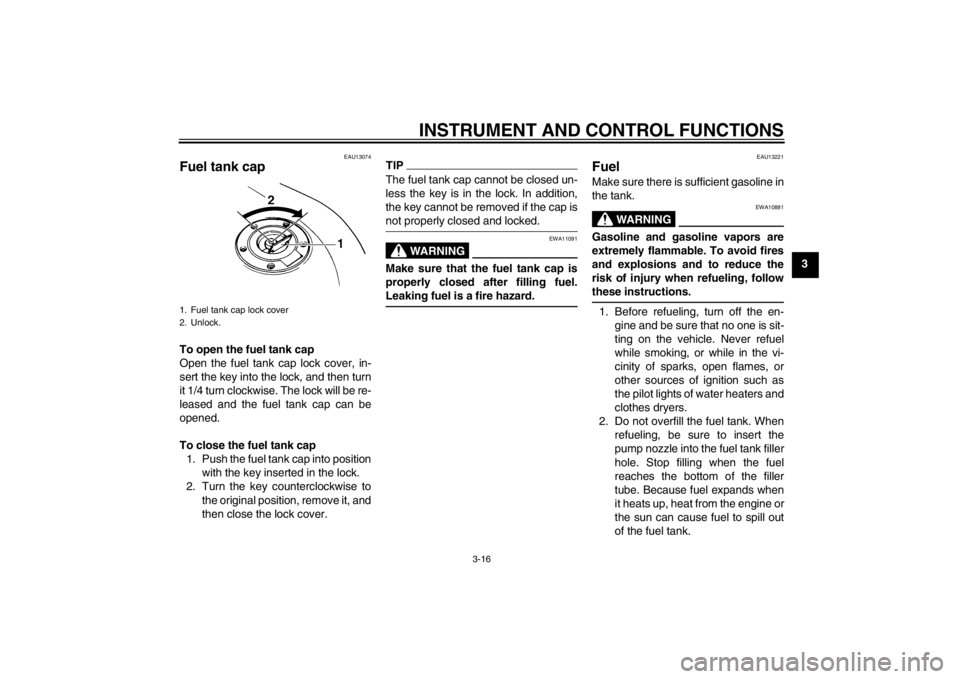
INSTRUMENT AND CONTROL FUNCTIONS
3-16
3
EAU13074
Fuel tank cap To open the fuel tank cap
Open the fuel tank cap lock cover, in-
sert the key into the lock, and then turn
it 1/4 turn clockwise. The lock will be re-
leased and the fuel tank cap can be
opened.
To close the fuel tank cap1. Push the fuel tank cap into position with the key inserted in the lock.
2. Turn the key counterclockwise to the original position, remove it, and
then close the lock cover.
TIPThe fuel tank cap cannot be closed un-
less the key is in the lock. In addition,
the key cannot be removed if the cap is
not properly closed and locked.
WARNING
EWA11091
Make sure that the fuel tank cap is
properly closed after filling fuel.
Leaking fuel is a fire hazard.
EAU13221
Fuel Make sure there is sufficient gasoline in
the tank.
WARNING
EWA10881
Gasoline and gasoline vapors are
extremely flammable. To avoid fires
and explosions and to reduce the
risk of injury when refueling, follow
these instructions.1. Before refueling, turn off the en-gine and be sure that no one is sit-
ting on the vehicle. Never refuel
while smoking, or while in the vi-
cinity of sparks, open flames, or
other sources of ignition such as
the pilot lights of water heaters and
clothes dryers.
2. Do not overfill the fuel tank. When refueling, be sure to insert the
pump nozzle into the fuel tank filler
hole. Stop filling when the fuel
reaches the bottom of the filler
tube. Because fuel expands when
it heats up, heat from the engine or
the sun can cause fuel to spill out
of the fuel tank.
1. Fuel tank cap lock cover
2. Unlock.
U1PWEAE0.book Page 16 Tuesday, February 7, 2012 4:21 PM
Page 32 of 102
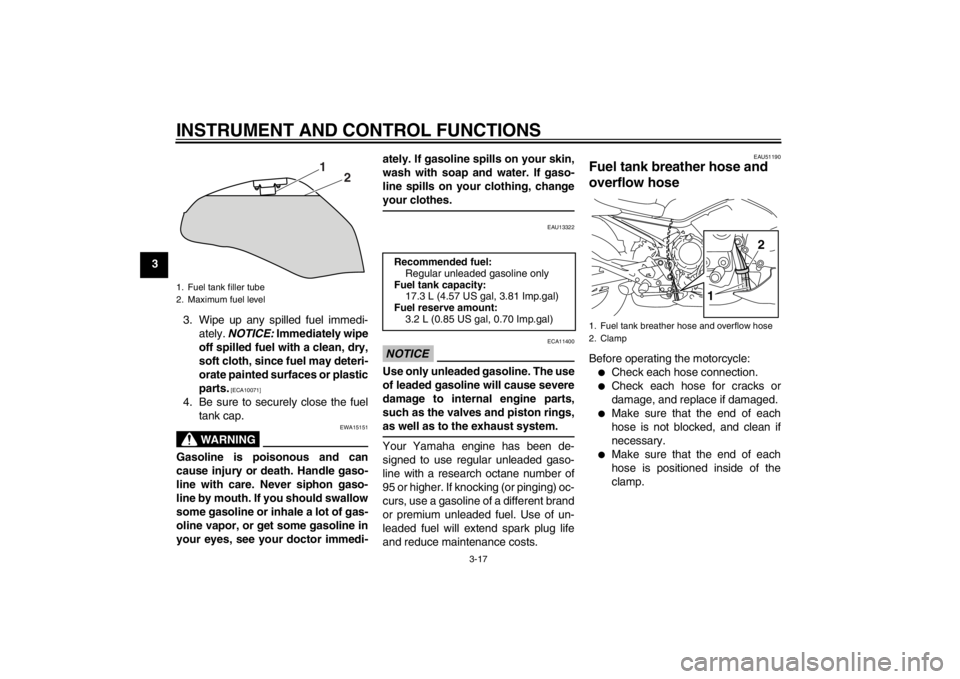
INSTRUMENT AND CONTROL FUNCTIONS
3-17
33. Wipe up any spilled fuel immedi-ately. NOTICE: Immediately wipe
off spilled fuel with a clean, dry,
soft cloth, since fuel may deteri-
orate painted surfaces or plastic
parts.
[ECA10071]
4. Be sure to securely close the fuel tank cap.
WARNING
EWA15151
Gasoline is poisonous and can
cause injury or death. Handle gaso-
line with care. Never siphon gaso-
line by mouth. If you should swallow
some gasoline or inhale a lot of gas-
oline vapor, or get some gasoline in
your eyes, see your doctor immedi- ately. If gasoline spills on your skin,
wash with soap and water. If gaso-
line spills on your clothing, change
your clothes.
EAU13322
NOTICE
ECA11400
Use only unleaded gasoline. The use
of leaded gasoline will cause severe
damage to internal engine parts,
such as the valves and piston rings,
as well as to the exhaust system.Your Yamaha engine has been de-
signed to use regular unleaded gaso-
line with a research octane number of
95 or higher. If knocking (or pinging) oc-
curs, use a gasoline of a different brand
or premium unleaded fuel. Use of un-
leaded fuel will extend spark plug life
and reduce maintenance costs.
EAU51190
Fuel tank breather hose and
overflow hose Before operating the motorcycle:●
Check each hose connection.
●
Check each hose for cracks or
damage, and replace if damaged.
●
Make sure that the end of each
hose is not blocked, and clean if
necessary.
●
Make sure that the end of each
hose is positioned inside of the
clamp.
1. Fuel tank filler tube
2. Maximum fuel level
1
2
Recommended fuel:
Regular unleaded gasoline only
Fuel tank capacity: 17.3 L (4.57 US gal, 3.81 Imp.gal)
Fuel reserve amount: 3.2 L (0.85 US gal, 0.70 Imp.gal)
1. Fuel tank breather hose and overflow hose
2. Clamp
1 1
2
U1PWEAE0.book Page 17 Tuesday, February 7, 2012 4:21 PM
Page 33 of 102
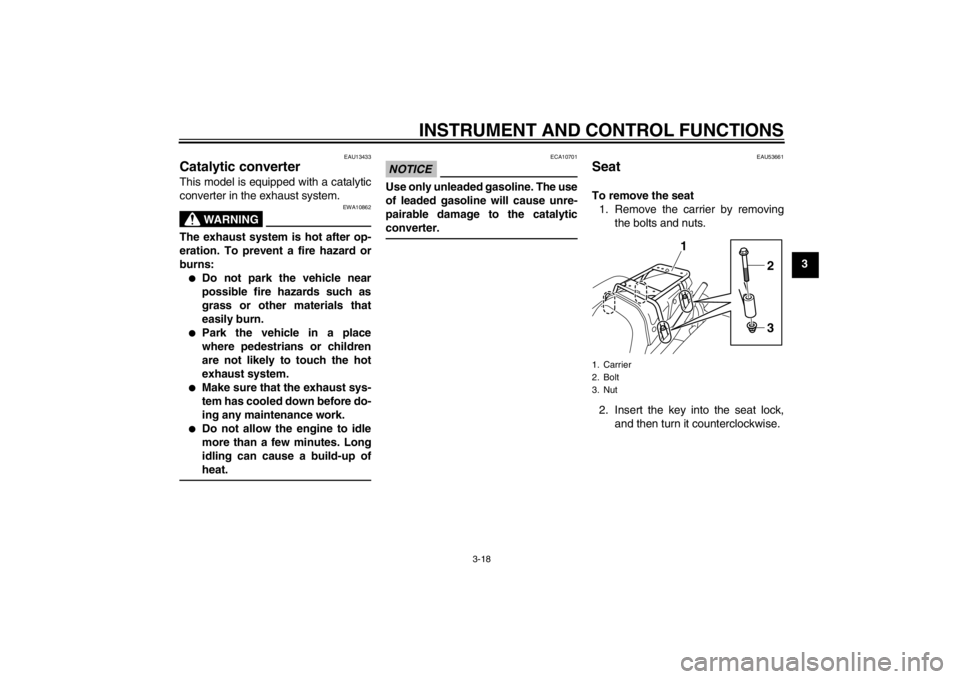
INSTRUMENT AND CONTROL FUNCTIONS
3-18
3
EAU13433
Catalytic converter This model is equipped with a catalytic
converter in the exhaust system.
WARNING
EWA10862
The exhaust system is hot after op-
eration. To prevent a fire hazard or
burns:●
Do not park the vehicle near
possible fire hazards such as
grass or other materials that
easily burn.
●
Park the vehicle in a place
where pedestrians or children
are not likely to touch the hot
exhaust system.
●
Make sure that the exhaust sys-
tem has cooled down before do-
ing any maintenance work.
●
Do not allow the engine to idle
more than a few minutes. Long
idling can cause a build-up of
heat.
NOTICE
ECA10701
Use only unleaded gasoline. The use
of leaded gasoline will cause unre-
pairable damage to the catalytic
converter.
EAU53661
Seat To remove the seat1. Remove the carrier by removing the bolts and nuts.
2. Insert the key into the seat lock, and then turn it counterclockwise.1. Carrier
2. Bolt
3. Nut
2
1
3
U1PWEAE0.book Page 18 Tuesday, February 7, 2012 4:21 PM
Page 34 of 102
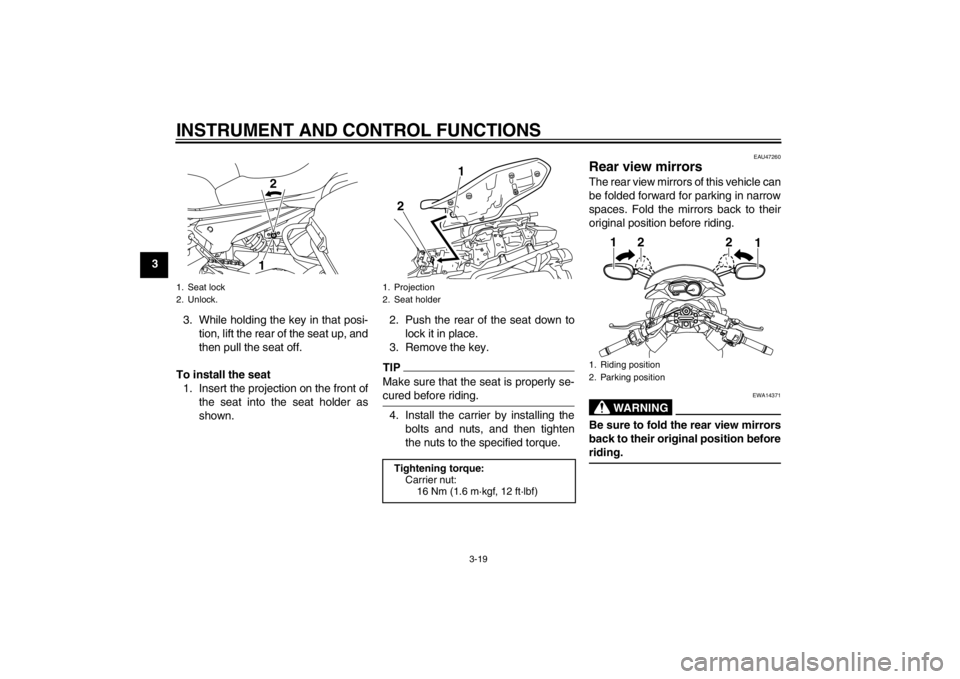
INSTRUMENT AND CONTROL FUNCTIONS
3-19
33. While holding the key in that posi-tion, lift the rear of the seat up, and
then pull the seat off.
To install the seat 1. Insert the projection on the front of the seat into the seat holder as
shown. 2. Push the rear of the seat down to
lock it in place.
3. Remove the key.
TIPMake sure that the seat is properly se-
cured before riding.4. Install the carrier by installing the bolts and nuts, and then tighten
the nuts to the specified torque.
EAU47260
Rear view mirrors The rear view mirrors of this vehicle can
be folded forward for parking in narrow
spaces. Fold the mirrors back to their
original position before riding.
WARNING
EWA14371
Be sure to fold the rear view mirrors
back to their original position before
riding.
1. Seat lock
2. Unlock.
12
1. Projection
2. Seat holderTightening torque:
Carrier nut:16 Nm (1.6 m·kgf, 12 ft·lbf)
1
2
1. Riding position
2. Parking position
12 2 1
U1PWEAE0.book Page 19 Tuesday, February 7, 2012 4:21 PM
Page 35 of 102
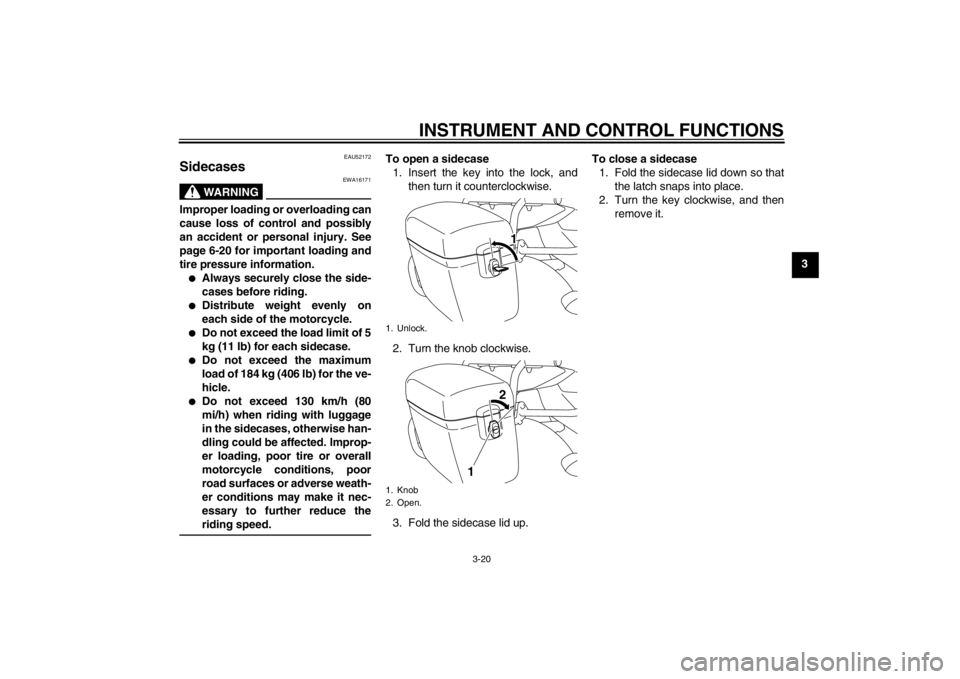
INSTRUMENT AND CONTROL FUNCTIONS
3-20
3
EAU52172
Sidecases
WARNING
EWA16171
Improper loading or overloading can
cause loss of control and possibly
an accident or personal injury. See
page 6-20 for important loading and
tire pressure information.●
Always securely close the side-
cases before riding.
●
Distribute weight evenly on
each side of the motorcycle.
●
Do not exceed the load limit of 5
kg (11 lb) for each sidecase.
●
Do not exceed the maximum
load of 184 kg (406 lb) for the ve-
hicle.
●
Do not exceed 130 km/h (80
mi/h) when riding with luggage
in the sidecases, otherwise han-
dling could be affected. Improp-
er loading, poor tire or overall
motorcycle conditions, poor
road surfaces or adverse weath-
er conditions may make it nec-
essary to further reduce the
riding speed.
To open a sidecase1. Insert the key into the lock, and then turn it counterclockwise.
2. Turn the knob clockwise.
3. Fold the sidecase lid up. To close a sidecase
1. Fold the sidecase lid down so that the latch snaps into place.
2. Turn the key clockwise, and then remove it.1. Unlock.
1. Knob
2. Open.
1 12
1
U1PWEAE0.book Page 20 Tuesday, February 7, 2012 4:21 PM
Page 36 of 102
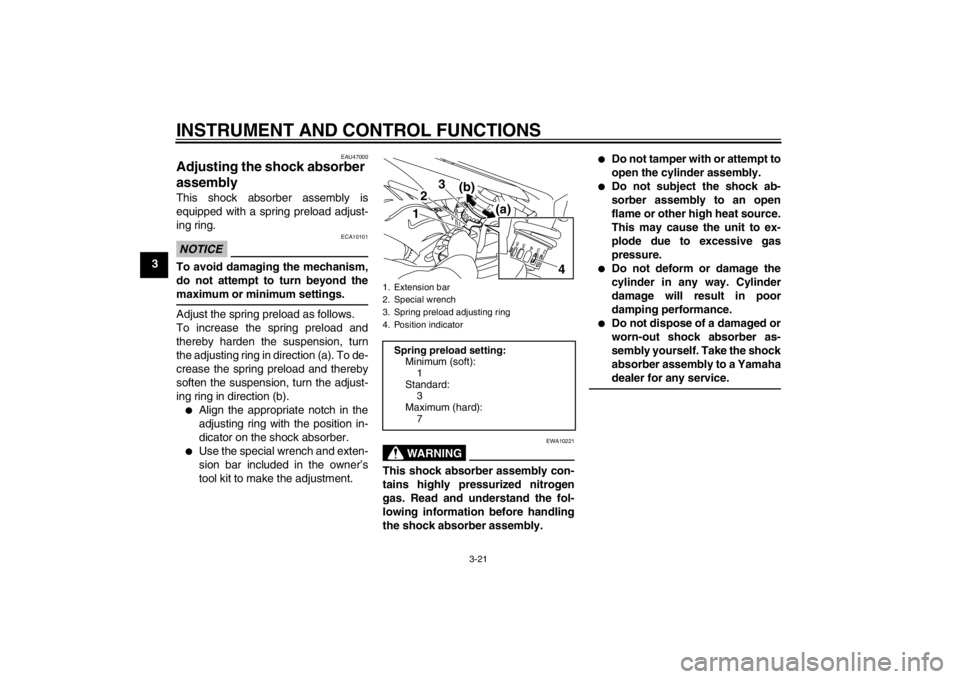
INSTRUMENT AND CONTROL FUNCTIONS
3-21
3
EAU47000
Adjusting the shock absorber
assembly This shock absorber assembly is
equipped with a spring preload adjust-
ing ring.NOTICE
ECA10101
To avoid damaging the mechanism,
do not attempt to turn beyond the
maximum or minimum settings.Adjust the spring preload as follows.
To increase the spring preload and
thereby harden the suspension, turn
the adjusting ring in direction (a). To de-
crease the spring preload and thereby
soften the suspension, turn the adjust-
ing ring in direction (b).●
Align the appropriate notch in the
adjusting ring with the position in-
dicator on the shock absorber.
●
Use the special wrench and exten-
sion bar included in the owner’s
tool kit to make the adjustment.
WARNING
EWA10221
This shock absorber assembly con-
tains highly pressurized nitrogen
gas. Read and understand the fol-
lowing information before handling
the shock absorber assembly.
●
Do not tamper with or attempt to
open the cylinder assembly.
●
Do not subject the shock ab-
sorber assembly to an open
flame or other high heat source.
This may cause the unit to ex-
plode due to excessive gas
pressure.
●
Do not deform or damage the
cylinder in any way. Cylinder
damage will result in poor
damping performance.
●
Do not dispose of a damaged or
worn-out shock absorber as-
sembly yourself. Take the shock
absorber assembly to a Yamaha
dealer for any service.
1. Extension bar
2. Special wrench
3. Spring preload adjusting ring
4. Position indicatorSpring preload setting:Minimum (soft):1
Standard: 3
Maximum (hard):
7
12
3
(a)
(b)
4
U1PWEAE0.book Page 21 Tuesday, February 7, 2012 4:21 PM
Page 37 of 102
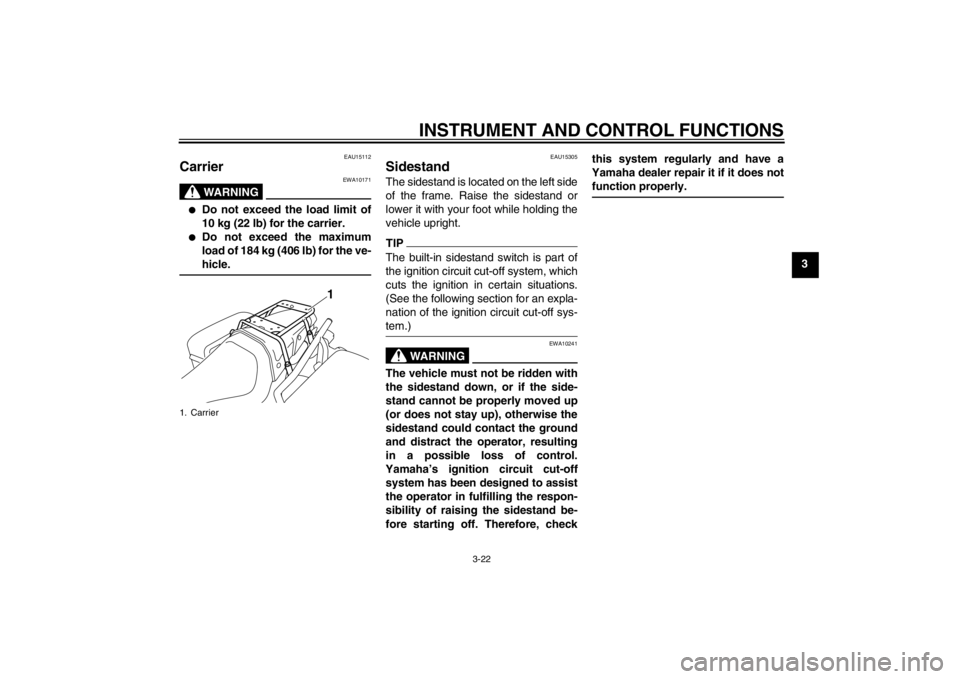
INSTRUMENT AND CONTROL FUNCTIONS
3-22
3
EAU15112
Carrier
WARNING
EWA10171
●
Do not exceed the load limit of
10 kg (22 lb) for the carrier.
●
Do not exceed the maximum
load of 184 kg (406 lb) for the ve-
hicle.
EAU15305
Sidestand The sidestand is located on the left side
of the frame. Raise the sidestand or
lower it with your foot while holding the
vehicle upright.TIPThe built-in sidestand switch is part of
the ignition circuit cut-off system, which
cuts the ignition in certain situations.
(See the following section for an expla-
nation of the ignition circuit cut-off sys-
tem.)
WARNING
EWA10241
The vehicle must not be ridden with
the sidestand down, or if the side-
stand cannot be properly moved up
(or does not stay up), otherwise the
sidestand could contact the ground
and distract the operator, resulting
in a possible loss of control.
Yamaha’s ignition circuit cut-off
system has been designed to assist
the operator in fulfilling the respon-
sibility of raising the sidestand be-
fore starting off. Therefore, checkthis system regularly and have a
Yamaha dealer repair it if it does not
function properly.
1. Carrier
1
U1PWEAE0.book Page 22 Tuesday, February 7, 2012 4:21 PM
Page 38 of 102

INSTRUMENT AND CONTROL FUNCTIONS
3-23
3
EAU44902
Ignition circuit cut-off system The ignition circuit cut-off system (com-
prising the sidestand switch, clutch
switch and neutral switch) has the fol-
lowing functions.●
It prevents starting when the trans-
mission is in gear and the side-
stand is up, but the clutch lever is
not pulled.
●
It prevents starting when the trans-
mission is in gear and the clutch le-
ver is pulled, but the sidestand is
still down.
●
It cuts the running engine when the
transmission is in gear and the
sidestand is moved down.
Periodically check the operation of the
ignition circuit cut-off system according
to the following procedure.
U1PWEAE0.book Page 23 Tuesday, February 7, 2012 4:21 PM
Page 39 of 102
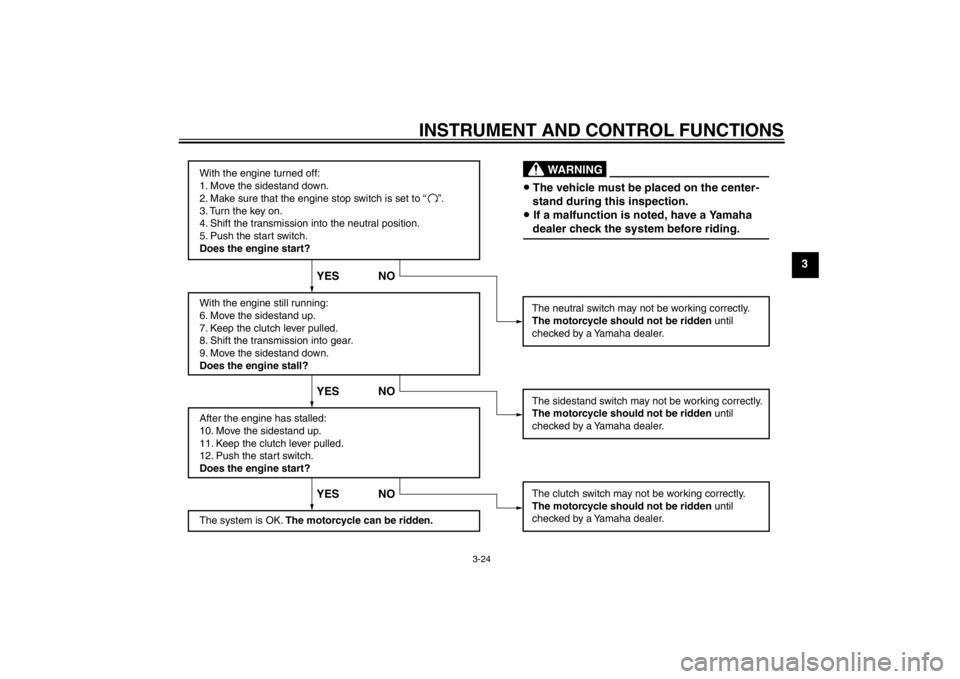
INSTRUMENT AND CONTROL FUNCTIONS
3-24
3
With the engine turned off:
1. Move the sidestand down.
2. Make sure that the engine stop switch is set to “
3. Turn the key on.
4. Shift the transmission into the neutral position.
5. Push the start switch.
Does the engine start?
With the engine still running:
6. Move the sidestand up.
7. Keep the clutch lever pulled.
8. Shift the transmission into gear.
9. Move the sidestand down.
Does the engine stall?
After the engine has stalled:
10. Move the sidestand up.
11. Keep the clutch lever pulled.
12. Push the start switch.
Does the engine start?
The system is OK. The motorcycle can be ridden.
YES NO YES NO YES NO
The neutral switch may not be working correctly.
The motorcycle should not be ridden until
checked by a Yamaha dealer.
The clutch switch may not be working correctly.
The motorcycle should not be ridden until
checked by a Yamaha dealer.The sidestand switch may not be working correctly.
The motorcycle should not be ridden until
checked by a Yamaha dealer.• The vehicle must be placed on the center-
stand during this inspection.• If a malfunction is noted, have a Yamaha
dealer check the system before riding.
WARNING
”.
U1PWEAE0.book Page 24 Tuesday, February 7, 2012 4:21 PM
Page 40 of 102
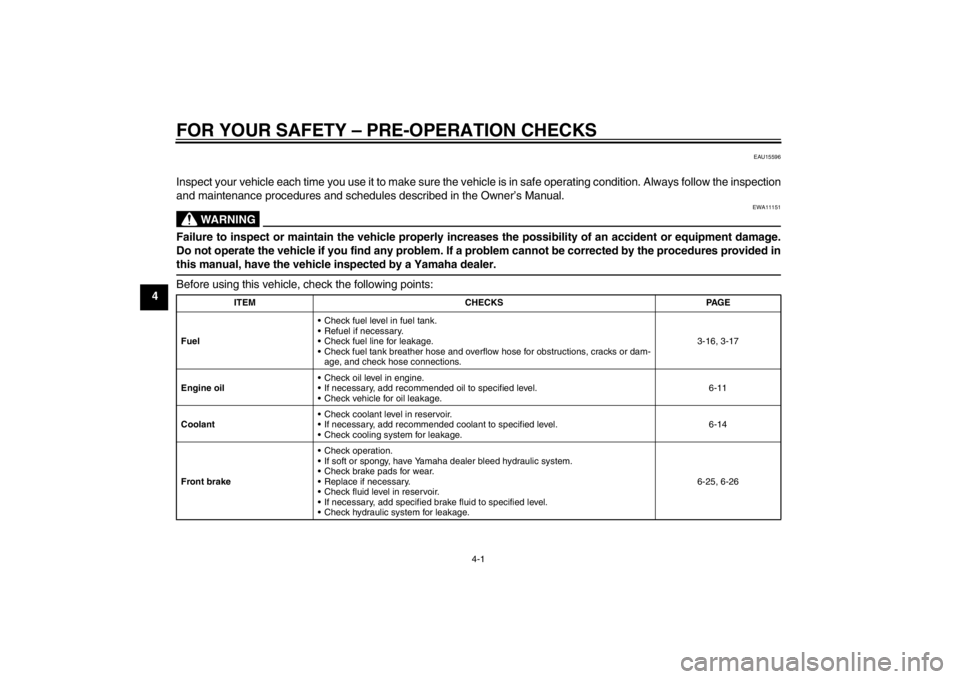
FOR YOUR SAFETY – PRE-OPERATION CHECKS
4-1
4
EAU15596
Inspect your vehicle each time you use it to make sure the vehicle is in safe operating condition. Always follow the inspection
and maintenance procedures and schedules described in the Owner’s Manual.
WARNING
EWA11151
Failure to inspect or maintain the vehicle properly increases the possibility of an accident or equipment damage.
Do not operate the vehicle if you find any problem. If a problem cannot be corrected by the procedures provided in
this manual, have the vehicle inspected by a Yamaha dealer.Before using this vehicle, check the following points:
ITEMCHECKS PAGE
Fuel Check fuel level in fuel tank.
Refuel if necessary.
Check fuel line for leakage.
Check fuel tank breather hose and overflow
hose for obstructions, cracks or dam-
age, and check hose connections. 3-16, 3-17
Engine oil Check oil level in engine.
If necessary, add recommended oil to specified level.
Check vehicle for oil leakage. 6-11
Coolant Check coolant level in reservoir.
If necessary, add recommended coolant to specified level.
Check cooling system for leakage. 6-14
Front brake Check operation.
If soft or spongy, have Yamaha dealer bleed hydraulic system.
Check brake pads for wear.
Replace if necessary.
Check fluid level in reservoir.
If necessary, add specified brake fluid to specified level.
Check hydraulic system for leakage. 6-25, 6-26
U1PWEAE0.book Page 1 Tuesda
y, February 7, 2012 4:21 PM